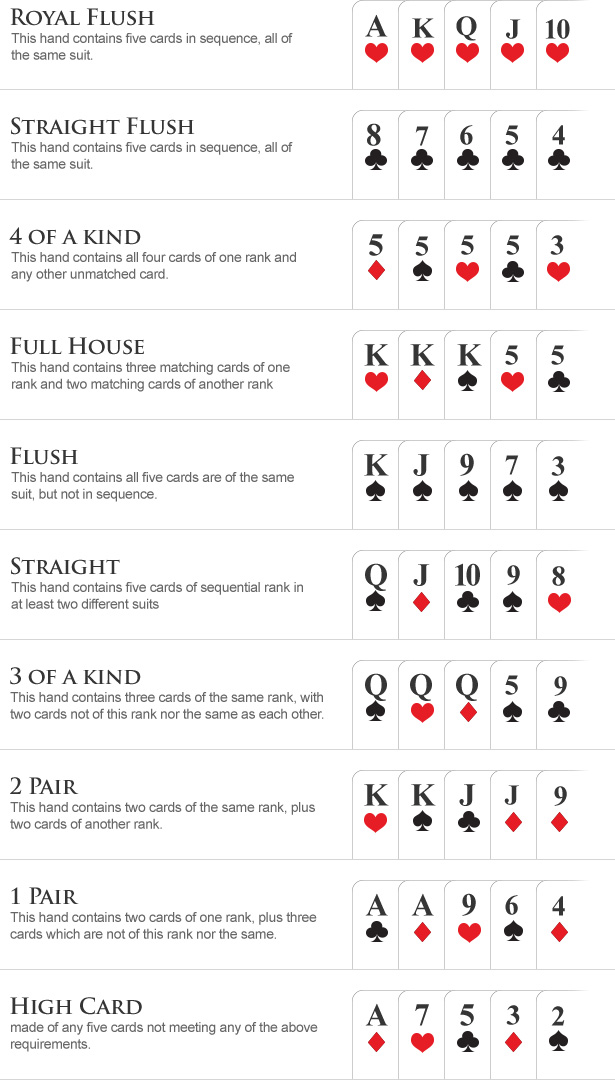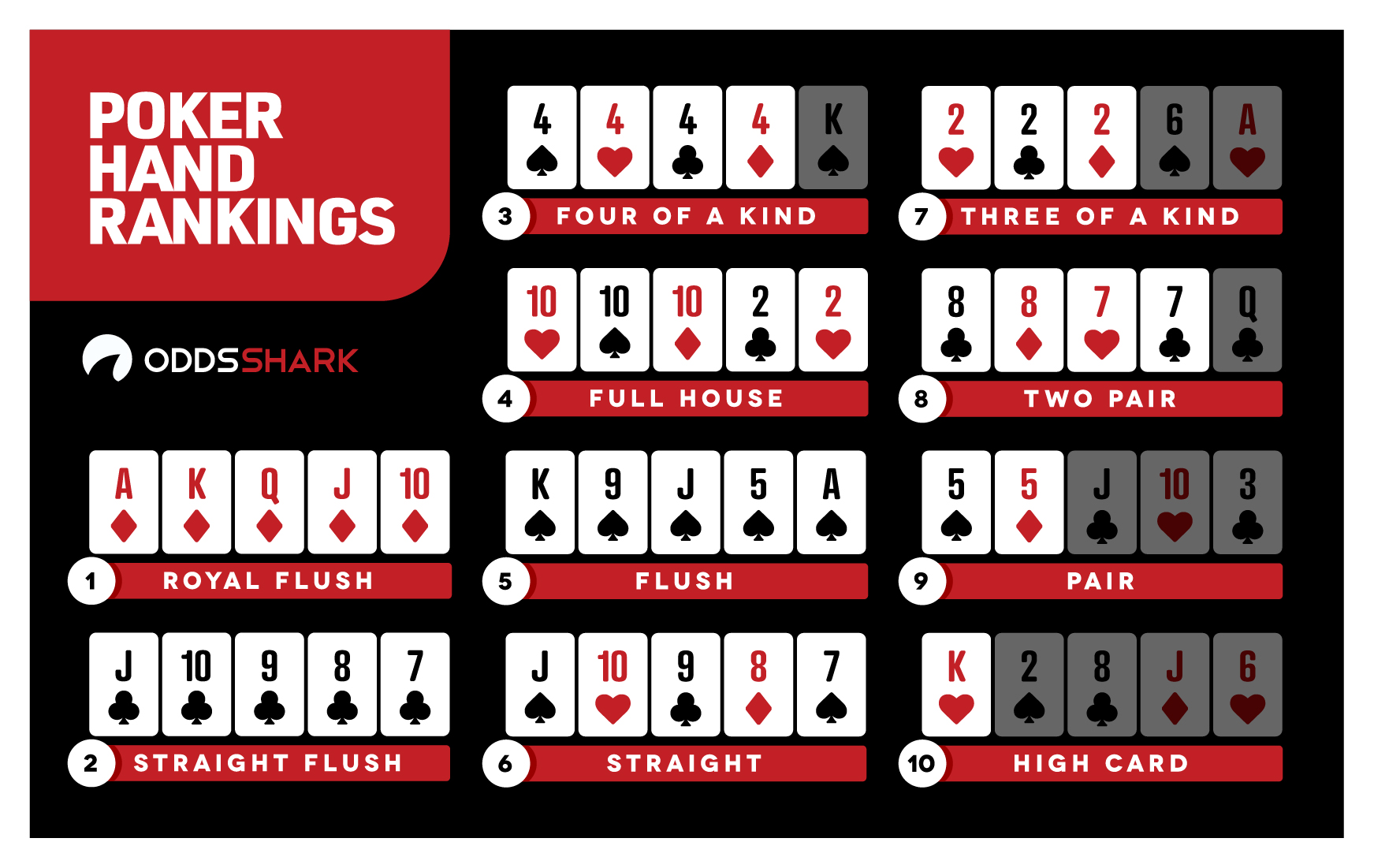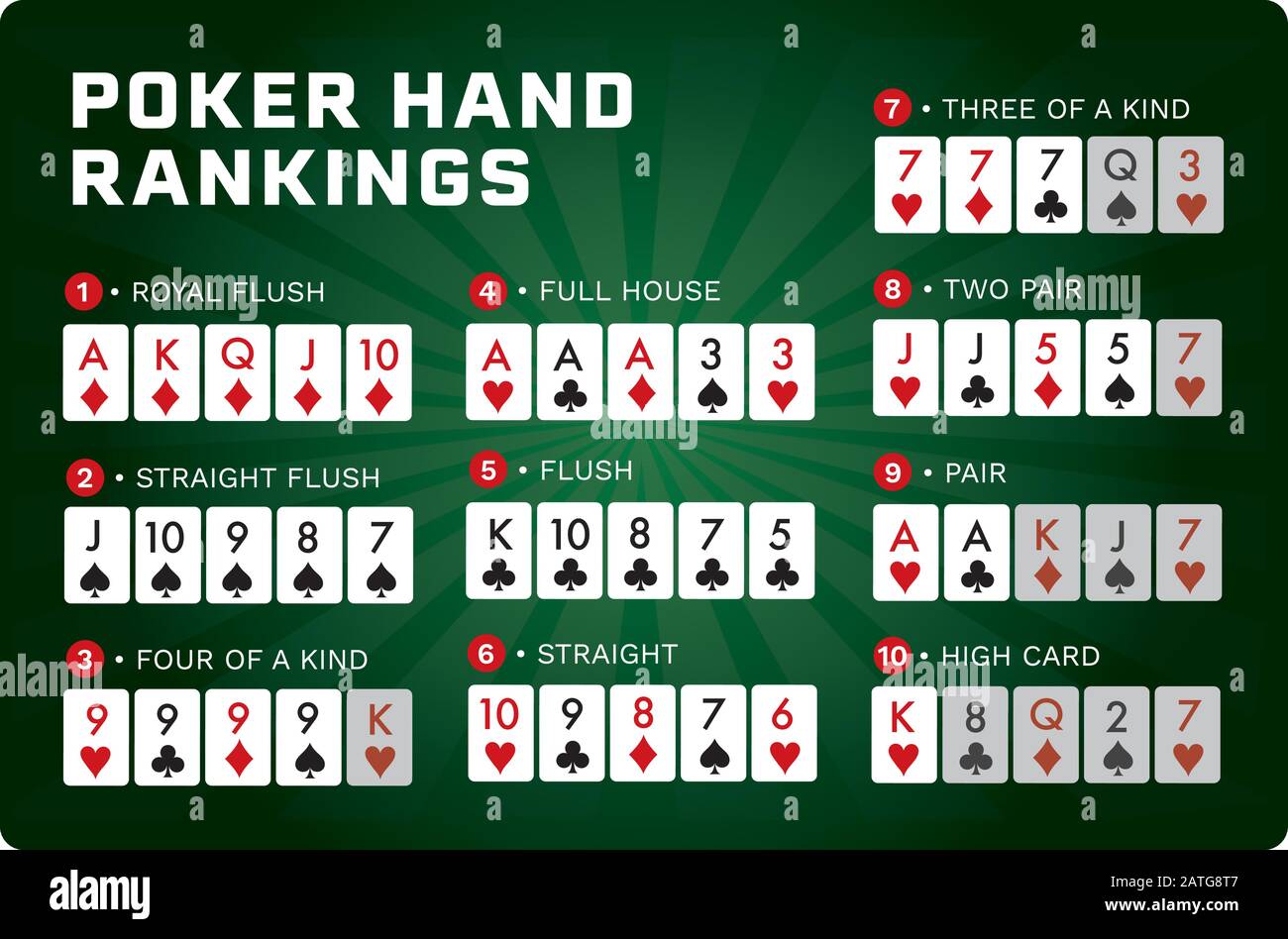Texas Holdem Poker Hands Ranking
Knowing what beats what in poker or Texas Hold’em is an important early step in learning the game. To help you out, I have provided for you an attractive printable or downloadable “cheat sheet” for both 5 card hand rankings as well as top 24 pre-flop starting hands.
Poker hands ranked from best to worst:
Check out the hand rank FAQ to help answer questions you might have about the ranking of hands in Texas Hold'em. The hands are in order from top to bottom, decreasing in value as you move down. An ace-high straight flush. It's just a straight flush really, but it's made with the 5 highest value cards. Note that the poker games Pot Limit Omaha and Texas Hold’em both share the same hand rankings format. Poker Hand Rankings Guide. Does a straight beat a flush? Does 2 pair beat a set? Use our poker hands reference chart until you are 100% certain of hand rankings. Poker hands from strongest to weakest. Poker Starting Hands - Comprehensive guide to which poker hands you should play, including a 2020 Texas Hold'em poker starting hands chart.
- Royal Flush
- Straight Flush
- Four of a Kind
- Full House
- Flush
- Straight
- Three of a Kind
- Two Pair
- One Pair
- High Card
To make things easier on you, I have included some handy charts that can be used to reference during play or even printed out.
Poker Hand Rankings Chart
Never forget what beats what again. Feel free to save this to your phone/tablet/computer or print the chart out.
Click below to download a high-quality PDF that includes a printable copy of both the showdown and pre-flop hand rankings.
The Top 24 Hold’Em Starting Hand Rankings
To help you out, I have also included the top 24 no-limit hold’em starting hands to give you a further idea of what beats what in poker. I based this list on both raw equities as well as post-flop playability.
I have used over 10 years of experience in both tournaments and cash games to compile this info. You get to benefit from my hard work!
How These Hands Were Determined
I took a look at a few of the pre-flop hand ranking charts out there and, while most appeared to get it right for the most part, there seemed to be something off.
The thing is, everyone always does pretty well on the top 5 or 6 hands. However, after that things get a bit murkier
So, what really matters when it comes to weighing hand strength? I decided to take a close look at the problem. Using the knowledge I’ve gained over the past few years, I tried to come up with a better way of codifying hand rankings.
Determining the Overall Playability of Each Hand
I decided to go about it from a logical standpoint. When deciding whether to play a hand or not, what are the factors a strong player considers before acting
So, I decided that there are basically two main factors to consider in determining the strength of a particular pre-flop hand. And, since equity is the tool we use to rank the value of hands I just had to figure out what type of equities matter most and then apply it to each factor
Once I was able to define which equities to consider, it just took a bit of math.
1. Pre-Flop Equity
The first equity I decided to factor in is a hand’s raw pre-flop equity. I mean, sometimes you need to get all-in before the flop, right?
Of course, some hands will get all-in more frequently than others but for the sake of simplicity, raw equity against a strong range will give us a decent enough metric to come up with a comparative ranking.

2. Post-Flop Equity
Secondly, we need to factor in how a hand does post-flop. There’s no doubt, that certain hands play much better after the flop than others.
To calculate how well a hand does after the flop I looked at what post-flop hands tend to get all-in most of the time in a post-flop scenario. This includes the strongest made hands, including top pair and better, as well as strong draws.
Once I was able to figure out what hands are likely to get all-in, I just had to figure out the equity of every hand versus that range on a random flop.
Compiling the Final List
Doing these kinds of calculations by hand would be extremely difficult and time-consuming. Luckily, there is a software program called Cardrunner’s EV that does the math for me.
After I figured out both the raw pre-flop equity and the likely flop equity of each hand, I just used excel to average them. That data was used to compile the rankings.
Here are the final equity percentages:
Which Poker Starting Hand Ranges Should I Use?
Knowing which hands to open raise is important to your success. Don’t worry, I’ve got you covered.
Free Basic Poker Strategy Charts
I have built charts that provide you profitable opening ranges from every position. As a bonus, the charts also include what to do at every decision point possible for playing a 20 to 40 big blind stack
The guide will give you an excellent starting point for playing No-Limit Texas Hold’em and will get you off on the right foot by allowing you to play fundamentally sound poker right now!
FAQ
What if my opponent and I have the same hand at showdown ?
If more than one player has the same hand then you have to follow the tie-breaker rules to determine the winner.
If two or more players have a flush or straight
In the case where two players have a flush or straight, the person who has the highest card in their hand wins. For example, T9876 beats 76543.
If two or more players have a full house
In the case of multiple full houses, the player with the highest “trips” as part of their full house wins. For example, TTT22 beats 555AA.
What if two or more players have the same pair or two pair?
If multiple players have exactly the same two pair, the highest kicker is used to determine the winner. For example, JJ66Q beats JJ66T.
The same process is used for one-pair. The next highest kicker is used. If that is the same, you use the next highest kicker. So on and so forth until the tie is broken. For example, AAK85 beats AAK84.
Who wins if more than one person has the same high card?
Similarly to one pair and two-pair hands, you use the next highest kicker to determine the winner. You keep moving on to the next kicker until a winner is determined. For example, KT763 beats KT753.
Which is better, trips or two-pair?
Three of a kind beats two-pair. It also beats a pair and high card.
Which is better, a flush or a straight?
A flush beats a straight. It also beats three of a kind, two pair, a pair, and high card.
What is the worst hand in poker?
The worst hand against multiple players is 72 offsuit. The worst hand heads-up is 32o.
What are the odds of getting a Royal Flush in Texas Hold’em?
A royal flush is extremely rare. You can only expect to get a royal flush once every 650,000 hands. That doesn’t mean it’s guaranteed. Personally, I have played well over 5 million hands and have only had one royal using both cards.
Final Thoughts
I hope this article has helped you learn more about how hand rankings work in poker. If you want to learn about basic poker strategy, be sure to check out my detailed no-limit hold’em basic tutorial.

For a certain segment of new hold’em players, starting hand charts can be fascinating. Even those with many years of experience who have little need to consult such charts still find them interesting as debate-starters.
In hold’em there are 169 different combinations of hands you can be dealt. For those of us who enjoy working with numbers or creating lists with which to organize our lives, there’s something appealing about the idea of ranking all of those hands from 1 to 169, even if we know such a list probably might have only limited value when it comes to actual game play.
In truth, there are actually a lot more possible combinations of hole cards in hold’em — 1,326 of them, in fact. But that total also considers suits as distinct, when in fact before the community cards come the suits are all essentially of equal value.
That is to say, is of the same value as when playing preflop, while and are also of equivalent value. So, too, are the different combinations producing the same pocket pairs all equal before the flop in terms of their relative worth. While there are six different ways to get pocket aces — , , , , , — you're equally happy no matter what suits the cards are.
So we get rid of all of those redundant hands and say that in Texas hold'em there are 169 “non-equivalent” starting hands, breaking them down as follows:
- 13 pocket pairs
- 78 non-paired suited hands (e.g., with two cards of the same suit like or )
- 78 non-paired unsuited hands (e.g., with two cards of different suits like or )
Notice now the non-paired combinations of hole cards neatly divide into equal groups, both of which are six times as large (78) as the smaller group of pocket pairs (13). The total of 169 combinations represents a square, too — 13 x 13 — another curious symmetry when it comes to hold'em hands.
Still, that’s a lot of starting hand combinations — too many for most of us humans to keep in our heads — which is one reason hand ranking charts are appealing and even can be useful, since they help players think about certain two-card combos as “strong” or “average” or “weak” as possible starters.
Setting aside the idea of actually ranking the 169 hands from best to worst, we might think for a moment about other ways of categorizing starting hands in hold’em, using that initial breakdown of hands into pocket pairs, non-paired suited hands, and non-paired unsuited hand as a first step toward coming up with further, smaller groups that are easier to remember.
The 13 pocket pairs we might group as big or “premium” (, , and ), medium ( through ), and small ( through ).
Meanwhile, we might divide each of the other groups into “connectors,” “one-gappers,” and “two-gappers” (and so on), further thinking of them also as “big,” “medium,” and “small” while also keeping separate suited and non-suited combinations.
These categories of non-paired hands are created by thinking about straight-making possibilities (affected by connectedness) and flush-making possibilties (affected by suitedness). There are more ways to make straights with “connectors” — that is, two cards of consecutive rank like — than with two-gappers, three-gappers, and so on. So, too, do you have a better chance of making a flush with suited hole cards than with non-suited hole cards.
Another possible group to create would include “ace hands” — i.e., non-paired hands containing one ace — that can be thought of as “big aces” (e.g., , ), “medium aces” ( down to ), and “small aces” ( to ). Or “king hands,” too. We like keeping these groups in mind, as hands with big cards like an ace or king can connect with flops to make big pairs.
In any case, you can see how these criteria for making categories can help when it comes to building those starting hand charts. And in fact most of those charts feature a similar ordering of hands, with...
- the premium pocket pairs and the big aces (suited and non-suited) up at the top;
- medium and small pocket pairs and big-to-medium suited connectors and one-gappers in the middle;
- and non-paired hands with less potential to make big pairs, straights, or flushes toward the bottom.
Would you like to get your hands on a free $10k entry to the WSOP Main Event?
Click on the link below and enter your email to participate to the free giveaway and take a shot at this massive opportunity!
Play NowHowever, there are problems with relying so heavily on starting hand charts that you don’t take into account factors that can make a given hand gain or lose value. Such as the flop. Or the turn. Or the river. Or other factors — including how your opponents are playing their hands — that can quickly affect the value of your starting hands.
After all, as anyone who’s played even a few hands of hold’em well knows, even if is the highest-ranking starting hand and a non-suited ranks as 169th, a couple of deuces among the community cards is all it takes to make the best hand worst and the worst hand best.
Learning the relative value of starting hands is definitely an important first step when it comes to getting started in hold’em. Other aspects of game play such as the importance of position, knowing when and how much to bet or raise, and thinking about opponents’ holdings and playing styles as hands proceed are good to learn, too, and help show how a great starting hand might not be so great five community cards later.
Poker is not blackjack, a game in which similar hand-ranking guides are sometimes used to inform players’ decisions about how to play. In poker you want to be wary about becoming too reliant on those pretty starting hand charts. They can be great for indicating which hands might be worth playing (and which should be thrown away), but troublesome if allowed to outweigh all of the other important factors that arise as a hand plays out.


That said, starting hand charts can be useful, especially for those new to hold’em. They also can be a big help when picking up other games, too, like pot-limit Omaha or the various stud games, if only to get an early idea what hands tend to play better than others.
Texas Hold'em Poker Hands Ranking Chart
But for many such charts ultimately are only themselves a way to get started, before the experience of playing helps players more instinctively recognize both hand groupings and how hands tend to compare in terms of profitability.
Get all the latest PokerNews updates on your social media outlets. Follow us on Twitter and find us on both Facebook and Google+!
Ranking Hands In Texas Holdem Poker
Tags
no-limit hold’emcash game strategytournament strategybeginner strategystarting hand selectionstarting hand chartsmath